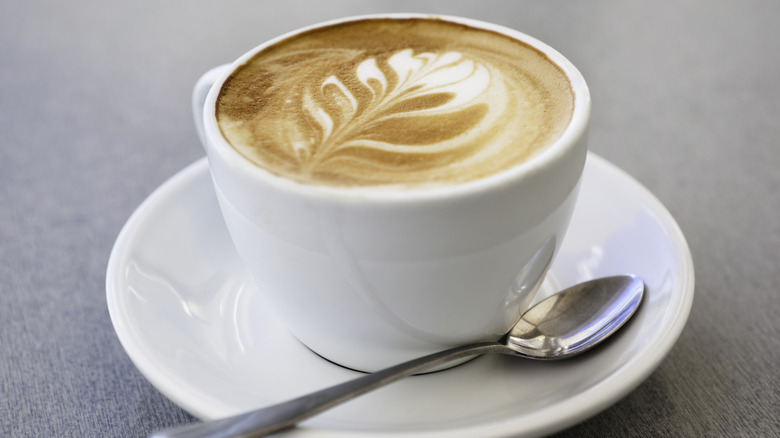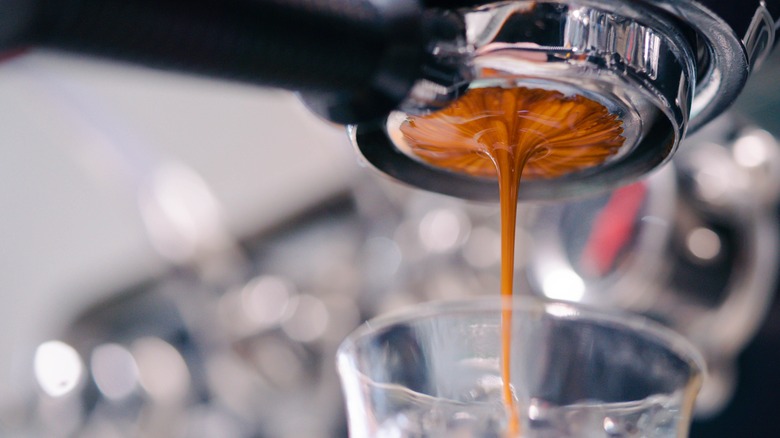The Flat White Explained For Coffee Novices
If you're a latte lover or a cappuccino connoisseur, there's another milky, espresso-based coffee beverage out there that will likely take your fancy: The flat white. There's a good chance you've heard of it — in North America, the flat white started getting popular around the mid-2010s, although it's been a standard coffee drink for much longer in some places like Australia. However, despite being relatively well-known, not everyone is clear on what separates the flat white from relatively similar drinks like a latte.
In short, a flat white is espresso topped with steamed milk: The milk will tend to be silky smooth, and not frothy, meaning it won't have the milk foam cap that you'd get with a cappuccino — some baristas will describe this light but not frothy texture as "microfoam." And while the milk texture is similar to a latte (with generally only a very thin foam cap on top), the flat white is less milky overall because of the drink size: Both should have the same amount of espresso but a latte is topped up with milk so it typically measures around 10 ounces. That's compared to 6 ounces for a flat white, meaning the coffee taste will be more concentrated. But take note: There's some variation here, with different coffee shops and baristas pouring different-sized drinks, typically around 5 to 6 ounces for a flat white, and 8 to 10 for a latte. But in any case, the flat white should have proportionately less milk.
Where the flat white came from
The flat white may seem relatively new to Americans, but it's been around for decades in a couple of countries: Australia and New Zealand. There's debate about which country is the "real" birthplace of the flat white, but in any case, the drink surfaced in both places in the 1980s or 1990s. The argument for Australia being the inventor goes like this: Australia already had a fairly well-established coffee culture due to post-war Italian immigration. There are various theories: One explanation is that Australian baristas weren't great at steaming milk to be cappuccino-level foamy, so the steamed-but-not-foamy milk became common in local coffee, resulting in the flat white. Some coffee buffs claim that it can be traced to the Moors Espresso Bar in Sydney in the mid-80s, but some more vaguely claim that it appeared somewhere in Melbourne or Sydney around that time.
On the other hand, some argue that the flat white was created by barista Derek Townsend at a cafe in Auckland, one of the country's first to focus on proper Italian-style espresso. The Townsend story dates to the early '80s, while another story gives credit to barista Fraser McInnes, who reportedly devised the flat white when working with hard-to-froth skim milk at a cafe in Wellington, New Zealand. Perhaps more likely is that, due to its similarities to other coffee drinks, there were multiple people who devised a low-froth milky coffee, and the term flat white just caught on generically.
Why it's so popular now
The flat white has now become a fairly standard coffee outside Australia and New Zealand: In the mid-2000s, Australians and New Zealanders brought it to the U.K., and a few years later, Australians brought it to New York specialty coffee shops and ultimately to the greater U.S. It hit the mainstream when big chains added it to their menus: It became a popular addition to the Starbucks menu in early 2015, boosting its popularity, and even McDonald's got in on it, offering flat whites from 2018 onwards in its McCafe offshoot.
But there are other arguments for why the flat white got so popular beyond the fact that it found its way into mainstream menus (after all, there has to be a reason why Starbucks hopped on the flat white train). Flat white fans tend to argue that it strikes a great balance between coffee and milk: The espresso isn't too intense, but it's also not too diluted by milk, as may be the case in a latte. There's even an idea that it's simpler (and therefore better) than a cappuccino because of the lack of frills — that is, it lacks the fluffy foam on top, although the two drinks are made pretty much the same way with no real difference in effort. In any case, if you're a latte drinker who is a little overwhelmed by milk, the flat white is for you.


